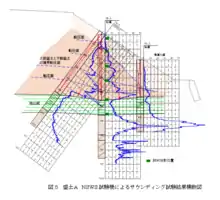

The Nippon Screw Weight System (NSWS)[1] is an on-site ground survey machine that examines the geotechnical engineering properties of soil.[2] The NSWS was developed to encounter weather abnormalities and natural hazards, saving human lives.[3]
Introduced in 2012 by the National Agriculture and Food Research Organization (NARO),[4] the NSWS was designed to overcome problems with the Method for standard penetration test (SPT).
NSWS was created by 耕三 大北, was the member of 311 earthquake disaster committee [5] of the Japanese Geotechnical Society.[6] The society released a report in June, 2012 proposing to the Japanese government a use of NSWS to investigate the aftermath of the 2011 Tōhoku earthquake and tsunami.[7]
Features
The NSWS is compact, weighs 120 kg,[8] and has wheels, making it suitable for ground measurement in crowded residential areas.[9] It costs much less than the conventional SPT test and triaxial compression test.[10][11]
NSWS can measure very soft zones, converted N-value of zero in the ground that had been considered difficult. It has 1.08 cm interval.SPT conducts the test every 50 cm, and 30 cm interval out of 50 cm is tested so the rest, 20 cm, is not measured; that means 40% of an entire hole is unknown. NSWS does not suffer from such a limitation.
NSWS can penetrate the ground diagonally and can cut through soft gravels. NSWS has in-situ shear test capability, the result of the joint research with NARO[12] and Okita-Ko Co., Ltd[13][14]
NSWS can prepare converted N-value, density, in-situ shear data for Stability Analysis. NSWS enables multi-point surveying due to its diagonal penetration capability and high-mobility. The multiple spots on the weak layers can be analyzed.
See also
References
- ↑ Inazumi, Shinya (2011). "In-Situ Ground Surveying by the NSWS Testing Machine" (PDF). International Journal of GEOMATE.
- ↑ "2) The Analysis Method for Ponds and Levees Preparing for Heavy Rain, and Earthquake test" (in Japanese). National Agriculture and Food Research Organization. 2012.
- ↑ Inazumi, Shinya (2011). "In-Situ Ground Surveying by the NSWS Testing Machine" (PDF). International Journal of GEOMATE.
- ↑ "The National Agriculture and Food Research Organization of Japan".
- ↑ "About Public Subscription for 311 Earthquake Disaster Committee". Japanese Geotechnical Society. 2011.
- ↑ "Japanese Geotechnical Society". Japanese Geotechnical Society.
- ↑ "About Publication of Challenge and Countermeasure for Earthquake Disaster at the Cause of Earthquake – Lessons and Proposition for 2011 East Japan Earthquake Disaster (1st Edition)" (in Japanese). Japanese Geotechnical Society.
- ↑ The older version weights 70kg. The newer NSWS, ver. 7, weights 120 kg but has more capabilities.
- ↑ Inazumi, Shinya. "A Presentation of Soil Investigation Example for Residentaial Embankment on Inclined Rock Mass and a Proposal of Reinforcement Material and Method".
- ↑ "Simplified strength analysis method for the slope of embankment such as a pond,in-situ rotation shear test(BST probe), Test manual(proposal) 1st edition" (PDF) (in Japanese). National Agriculture and Food Research Organization of Japan. 2013.
- ↑ "Rotational Shear Test in Borehole (BST Probe) Guideline for Cost Index (Proposal)" (PDF) (in Japanese). National Agriculture and Food Research Organization of Japan. 2013.
- ↑ "The National Agriculture and Food Research Organization of Japan".
- ↑ "NSWS(Nippon Screw Weight System)". Okita-Ko Co., Ltd.
- ↑ "2) The Analysis Method for Ponds and Levees Preparing for Heavy Rain, and Earthquake test" (in Japanese). National Agriculture and Food Research Organization. 2012.
External links
- National Agriculture and Food Research Organization of Japan Independent Administrative Agency of Japan specialized in research and development of agriculture and food.
- Japanese Geotechnical Society